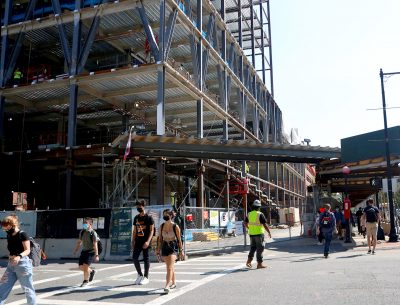Since Boston University unveiled its plans for the new Center for Computing and Data Sciences in 2018, its unique stacked design almost immediately inspired students on campus to create the affectionate nickname, “the Jenga building.”

The Center for Computing and Data Sciences is set to be completed next summer, and in the meantime, the construction on campus will continue on the 19-story building. The opening of the building will also mark the beginning of a new department at BU, the Department of Computing and Data Sciences. The department is also unveiling a new major program, the Data Sciences major, starting this Fall.
Ran Canetti is a professor of computer science in the College of Arts and Sciences and is a founding faculty member of the new department. He said the height of the new building is similar to that of the BU School of Law building and disagrees with perceptions that the building would be “an eyesore” campus.
“It definitely stands out, it’s actually supposed to stand out,” Canetti said.
Alyssa Goins is a junior majoring in computer science and math in the College of Arts and Sciences. She said that the construction of the new building doesn’t bother her, and she’s excited for the CS program to have a specific space.
“I would say it’s really nice that as a computer science major that we have a designated building now for data sciences,” Goins said. “I think that’s super cool.”
Canetti was on the design team back in 2013 when talks of a building specifically for computer science, statistics and mathematics arose. He said the building’s design promotes more collaboration across the field and community at BU.
“One very nice thing about the building design is openness,” he said. “It would create opportunity for collaboration which … will really make an impact [as] one big unit as opposed to siloed departments.”
Rosie Sullivan, the programs and communications manager for the Faculty of Computing & Data Sciences, said the building represents a new step for BU, which hasn’t built an academic building like the Center for Computing and Data Sciences in almost 15 years.
“It’s going to be 100% fossil [fuel] free, with many zero-waste initiatives. While CDS serves as the anchor tenant, we are so excited to be sharing the space with the Departments of Math & Stats, Computer Science, and the Hariri Institute,” she wrote in an email. “It’s going to be an extremely collaborative space.”
The building is the first on BU campus to be fossil fuel-free, and it also includes other environmental sustainability measures like no gas, beautiful staircases to encourage physical activity, triple-glazed insulated glass windows and less chemicals.
But while the building’s going up, students are subject to the construction noise and view from Warren Towers. Sullivan said the construction will inspire students and keep them interested in the new addition to campus.
“We believe having a hub of activity in the center of campus will spark excitement,” she wrote in an email. “We hope students will be curious about what is going on and what is coming.”
For many professors, this building will solve the problem of “inadequate faculty space across campus right now and many [professors] are dispersed across campus,” according to Sullivan.
Goins said that while the building is exciting, the design’s modern look won’t blend in on campus.
“I will be honest, it’s a very interesting building design but at least we’ll stand out on campus,” Goins said.
Canetti said that the design “creates this very nice woven sense” and he likes the design because he hasn’t seen it before. The stacked floors will also allow for porches and balconies up the whole building.
“Now, we are very excitedly watching it every day as it’s being built a little bit more,” Canetti said, “and really looking forward for it to really be there.”
Correction: Ran Canetti later specified that the similarities between the BU School of Law building and the Center for Computing and Data Sciences was not the architecture, but the height.
A previous version of this story unclearly represented Canetti’s views. The article was updated to more clearly reflect Canetti’s views.





























































































































John Sand • Sep 9, 2021 at 6:31 am
I have two primary concerns. One, the risk of creating more wind tunnels in the winter, with the removal of an open space. Second, was it not possible to replace the parking lot with a green space? More buildings exacerbates the urban island effect.